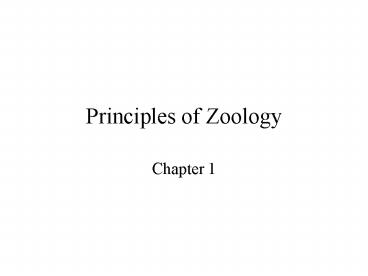Principles of Zoology PowerPoint PPT Presentation
1 / 19
Title: Principles of Zoology
1
Principles of Zoology
- Chapter 1
2
Biology
- Science that deals with the life processes and
characteristics of plants and animals - Biology is broken into 2 main branches
- Botany-dealing with plants
- Zoology-dealing with animal life
3
Zoology
- The zoology of a particular kind of animal is a
description of the life, growth, structure or
anatomy, nutrition, reproduction, and
classification of that animal.
4
Fauna
- Community of animals that are found in a
particular region
5
Classification of Animals
- Purpose organization of the animals into like
groups - Animals are classified into groups based on
genetic and structural similarities to other
animals - The field of science dealing with these
classifications is known as TAXONOMY
6
Animal Plant Kingdoms
- Includes ALL of the animalsanimal kingdom
- Includes ALL of the plantsplant kingdom
- See Figure 1-1 on page 3
7
Classification of Animals
- KINGDOM
- PHYLUM
- CLASS
- ORDER
- FAMILY
- GENUS
- SPECIES
8
Animal Behaviors and Habits
- Instinctive vs learned
- What is meant by instinctive behavior?
- What is an example of this?
- What is a learned behavior pattern?
- What is an example of this?
9
Animal Structure or Anatomy
- The animals structure enables its survival
- Why or how?
- Body parts
- Stomach-RUMEN VS NON RUMINANT
- Evading predators
- Running
- Teeth
- Cold blooded vs. warm blooded
10
Structure
- Includes the arrangement of the bones in the
skeleton and the attachment of the muscles on the
bones - Structure also includes unique features such as
feathers, hair or scales - Structure includes the way that internal organs
are designed and arranged. - Examplebirds do not have teeth, but do have a
gizzard where food is ground into tiny pieces by
rocks
11
Structure Cont.
- The way an animal moves is controlled to an
extent by the animals size and structure - Whales could not survive out of the water because
of their size. The natural buoyancy of their
bodies in deep water makes it possible for them
to move. - Birds are typically light weight allowing them to
fly.
12
Animal Nutrition and Digestion
- Growth and repair of living cells
- Energy is necessary to form chemical bonds-cell
formation - Warm blooded animals require energy to maintain
body temperature - Muscle flexes etc.
13
Animal Nutrition and DigestionCont.
- How animals obtain nutrition differs between
animals - Plant eaters
- Meat eaters
- Both
- We will discuss this in more detail in the next
chapter
14
Animal Nutrition and DigestionCont.
- SIMPLE STOMACH
- One compartment. Does not have a large capacity
so foods with a relatively high concentration of
nutrients must be eaten. - Grains and meats are ideal
- RUMINANT STOMACH
- Four compartments. Large capacity. Foods that are
high in fiber but low in nutrition value can be
utilized better - Explain ruminant stomach
15
Animal Nutrition and DigestionCont.
- Birds
- CROP-food absorbs water and is softened
- GIZZARD-food is ground into smaller pieces by
rocks
16
Animal Growth
- Each animal grows rapidly as a newborn. This
growth is necessary so it can mature - Cells divide to form new cells
- Growth occurs when body cells divide at a faster
rate than they die - The type of cell division that results in growth
of the body is called MITOSIS
17
MITOSIS
- Several steps occur during mitosis
- Figure 1-13
- Each cell exists for most of its life span in a
non-reproductive stage called INTERPHASE - PROPHASE-the first stage of active cell
reproduction - During this stage the membrane around the nucleus
disappears and the chromosomes appear
18
MITOSIS cont.
- Each chromosome has been replicated and each half
of the duplicated chromosome is known as a
CHROMATIDthe point where the chromatids are
attached is called the centromere - After PROPHASE, you have METAPHASE
- During this stage, the chromosomes are pulled to
the center of the cell by fibers attached to cell
structures called CENTRIOLES that have migrated
to opposite sides of the cell - These fibers or spindles are attached to the
centromeres that connect the pairs of chromosomes
together
19
MITOSIS cont.
- During ANAPHASE, the chromatids are pulled apart
by the spindles as the cell elongates. - A full set of chromosomes becomes evident on
opposite sides of the cell during anaphase.

